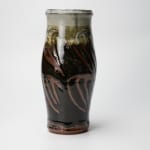Hamada Shoji 濱田庄司 1894-1978
Tenmoku glazed vase
Stoneware
H11 3/8 × Dia 5 1/4 in.
H29 × Dia 13.5 cm
H29 × Dia 13.5 cm
With signed wood: signed by his son, Hamada Shinsaku
%3Cdiv%20class%3D%22artist%22%3EHamada%20Shoji%20%E6%BF%B1%E7%94%B0%E5%BA%84%E5%8F%B8%3C/div%3E%3Cdiv%20class%3D%22title_and_year%22%3E%3Cspan%20class%3D%22title_and_year_title%22%3ETenmoku%20glazed%20vase%3C/span%3E%3C/div%3E%3Cdiv%20class%3D%22medium%22%3EStoneware%3C/div%3E%3Cdiv%20class%3D%22dimensions%22%3EH11%203/8%20%C3%97%20Dia%205%201/4%20in.%3Cbr/%3E%0AH29%20%C3%97%20Dia%2013.5%20cm%3C/div%3E%3Cdiv%20class%3D%22signed_and_dated%22%3EWith%20signed%20wood%3A%20signed%20by%20his%20son%2C%20Hamada%20Shinsaku%3C/div%3E
Further images
-
(View a larger image of thumbnail 1
)

-
(View a larger image of thumbnail 2
)

-
(View a larger image of thumbnail 3
)

-
(View a larger image of thumbnail 4
)

-
(View a larger image of thumbnail 5
)

-
(View a larger image of thumbnail 6
)

-
(View a larger image of thumbnail 7
)

-
(View a larger image of thumbnail 8
)

-
(View a larger image of thumbnail 9
)

-
(View a larger image of thumbnail 10
)

-
(View a larger image of thumbnail 11
)

'When I moved there in 1924, Mashiko was for decades creating grinding bowls, jars and teapots that were used throughout the Kanto Plains, yet no one would know where these...
"When I moved there in 1924, Mashiko was for decades creating grinding bowls, jars and teapots that were used throughout the Kanto Plains, yet no one would know where these ceramic vessels came from. I was impressed by the fact that there was a kiln site so close to Tokyo that was still virtually pristine, and washing away what I had learned from my time studying in Tokyo and Kyoto, I began to pursue this purity in health in both my way of life and in my work. For this reason, I chose to use materials only from Mashiko, my potter's wheel, my clay and my glazes." - Hamada Shoji
Share
- X
- Tumblr
1
of
14












